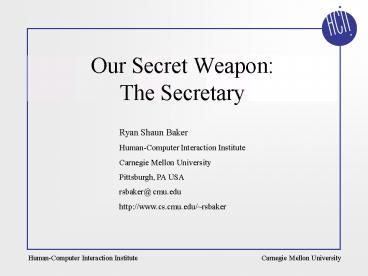Our Secret Weapon: The Secretary PowerPoint PPT Presentation
Title: Our Secret Weapon: The Secretary
1
Our Secret WeaponThe Secretary
Ryan Shaun Baker Human-Computer Interaction
Institute Carnegie Mellon University Pittsburgh,
PA USA rsbaker_at_ cmu.edu http//www.cs.cmu.edu/rsb
aker
2
Situationally Appropriate Interfaces
- This is a huge area
- I will focus on one sub-area
- When do we allow full-scale interruptions?
- Not just a little ignorable hint at the periphery
- But a full scale STOP and pay attention!
3
Interrupting The User
- Sometimes well want to interrupt our user
- Sometimes we wont
- How does our system decide?
4
A model secretaries
- Secretaries already deal with deciding whether or
not to allow interruptions - Take this example of a deans secretary denying
an interruption
5
An intruder
- AA Sorry, do you have an appointment?
- I Oh, no, do I need one?
- AAYes, you do.
- II cant see him right now?
- AANo, you cant.
- IAll right, when can I see him?
- AAUm, when are you available?
- IUm, I have a, how about tomorrow?
- AAOk, tomorrow after noon? 2 oclock?
- IUm, sure. Okay.
- AAOkay.
6
Analysis
- In this situation, the secretary
- Prevented an unwanted interruption
- Scheduled an appropriate time for the business to
take place
7
Subtle cues about the user
- Theres a lot of value to studying subtle cues
about what the user is doing - Heart rate, skin electric valence, pattern of
speech, gaze, attention, and so on - But secretaries make a lot of decisions to allow
and disallow access without this information - Often they cant even see the user
8
Sophisticated Models
- Secretaries have sophisticated models for when to
allow interruptions (phone and face-to-face) - These models are formed in part by explicit
instructions - These models also include reasoning which is not
based on explicit instructions
9
Work Model
- Lets say we could perfectly sense when a user
was in a meeting with one other person, with each
talking an equal amount - This is not enough to be able to decide if we
should interrupt - We need some sense of the importance of the
meeting, and the importance of the interruptor
10
Developing a Model of Importance
- Give diaries to several secretaries who
- Control face-to-face access to a faculty member
- Control phone access to a faculty member
- Ask them to record
- every attempted interruption
- whether the person was granted access if not,
what action was taken - every time they were explicitly asked by the
faculty member to give or deny access - if they were not going from explicit
instructions, why they chose to allow or deny
access
11
Developing a Model of Interruptions
- Why Diaries?
- Because Contextual Inquiries are unlikely to
generate enough cases in any reasonable amount of
time - Because Retrospective Interviews will inherently
miss a lot of cases, and may be more focused on
memorable cases than everyday ones
12
Developing a Model of Interruptions
- Also, we will give diaries to a couple faculty
members and ask them for one day - Every half hour while they are at the university
- Write down a one-phrase description of what
activity they are currently engaged in (meeting
with the dean, teaching class, reading email)
13
Developing a Model of Interruptions
- This will give us a list of the situations these
faculty members find themselves in - We dont (at this point) want their reports on
whether or not they think they would be
interruptible, because they would be
differentially interruptible by different people.
(making them go through a list would probably be
overkill)
14
Developing a Model of Interruptions
- Given this, develop a system which will
- Support all of the explicit requests our faculty
members use - Will have categories for different types of
interruptors and situations, based on our data - Will have rules for when an interruption is
acceptable (in the absence of explicit
information, and even sometimes going against
explicit information)
15
Learning
- We will use develop this system using an initial
model of the situations and categories of
interruptors, and then taking a set of training
data (again, from diaries) on when interruptions
were accepted and not accepted - Then we will run a learning algorithm (FOCL?) to
develop a set of rules for when interruptions
should and should not be allowed

